 Sculpey III: the polymer clay serious artists love to hate. When a newbie comes on the scene, the advice from the veterans is always the same: “Get rid of all of that Sculpey you bought before you knew any better and get yourself some real clay, like Fimo, Premo, or Kato.”
Sculpey III: the polymer clay serious artists love to hate. When a newbie comes on the scene, the advice from the veterans is always the same: “Get rid of all of that Sculpey you bought before you knew any better and get yourself some real clay, like Fimo, Premo, or Kato.”
I learned to clay 11+ years ago, and like most new to the craft, I started with several bars of Sculpey III. I loved it. Unfortunately, a lot of what I made became useless when the fragile parts started to snap off. Frustrated, I tried other brands. I switched to Fimo but swore off of it after completing 4 nativity scenes one Christmas season while I was still using a plastic roller and an x-acto knife as my only tools. That was an exercise in complete frustration. I flirted briefly with Promat but found it, too, was harder than I liked. When Premo came out, I fell in love with it – it was soft enough not to be frustrating, but strong enough not to break when I looked at it sideways.So, for a few years I was a Premo girl. These were also the years where I did the most experimenting. Eventually, I found my niche in caning. I was particularly enamored with repeating patterns and I liked tiling cane slices together to make sheets that would be useful as veneers. But there was a problem – the Premo canes I made didn’t age particularly well. Every slice I wanted to use had to be warmed up in my hands (which don’t really have much of their own warmth to spare) and even after warming, it didn’t meld well with the other cane slices next to it, nor did it stretch well when run through the pasta machine. I couldn’t use my Premo canes in my applications once they had been sitting around for a while, and that wasn’t going to work for me.
So, I went back to my roots and started caning with Sculpey III. I needed a lighter touch when reducing the canes, but that wasn’t a problem for me. And I needed to take into account the fact that Sculpey is not known for its strength after curing. I could use it for caning, but not as a structural element. I adapted all of my designs so that the primary items were constructed with Premo, and a very thin veneer of one of my Sculpey canes was applied. In most designs, I also added another layer of protection by coating the design with Liquid Kato Polyclay. Sandwiched in between two very strong clays, the ultra thin layer of Sculpey has not posed a structural problem in the least.
It seems that most people serious about polymer clay, particularly those who do caning, prefer the stiffer clays. Newbies are warned off of Sculpey as “too soft for caning.” Well, I’m here to tell you that it is certainly possible to make appealing cane designs in a soft clay. If you don’t have super hot hands, if you can reduce with a light touch, and you use a strong clay for the structural elements of your design, then Sculpey III is a perfectly legitimate option. I have made hundreds of Sculpey canes, mostly in repeating patterns. Many of my canes are several years old, and when I slice them they are still as fresh and as supple as the day I made them. They stretch beautifully in the pasta machine and they meld seamlessly with the slices next to them when forming a clay “fabric.”
This weekend I learned Jana Roberts Benzon’s Arabesque Caning technique. I brought a stiff clay to class as instructed, but I was curious if Sculpey could be used for such an intricate design. Since I have a tendency to work quickly in a workshop setting, I brought some Sculpey to try out the technique during any downtime I had. At the end of class, in addition to the cane we were supposed to be making, I also had an approximately 4-inch tall triangular cane made of Sculpey.
I wasn’ t overly surprised that Sculpey was acceptable for all of the components of the cane, but I do have to admit to a small doubt about its ability to withstand the reduction process. I generally make canes that are only about 6-8 ounces. This was much bigger than that and I was afraid I’d turn it into mush. I was unable to attend the Philadelphia guild meeting today where Jana was going to go through the reduction process, but armed with her written instructions this morning, I plopped down on the floor in my pajamas with my cane and went to town. Well, wouldn’t you know, the cane reduced beautifully, with minimal waste, and all of the crisp detail intact.
This, my friends, is a very complex, very detailed precision cane made entirely out of Sculpey III:
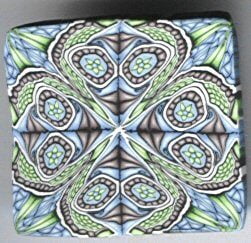

And just for kicks, here are some items that I made from that cane this afternoon:
All of these items encase the paper-thin Sculpey cane slices in a sandwich with a thick slice of Premo and a layer of liquid Kato clay so they won’t break easily.
I’ll be the first to admit that caning with Sculpey isn’t for everyone, but I do think that it deserves a far better reputation than it gets. I’m looking forward to playing around with Jana’s technique and encorporating ideas from it into my own work. I see a Paisley cane in my future…
Lisa


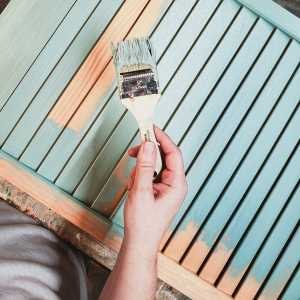
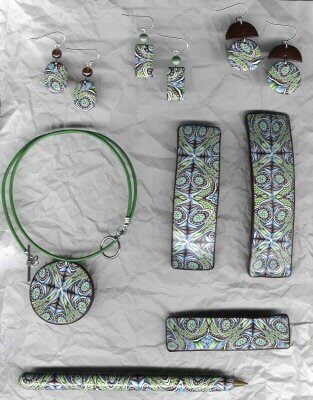


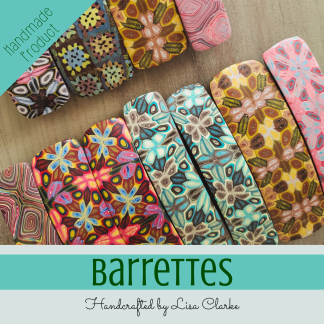

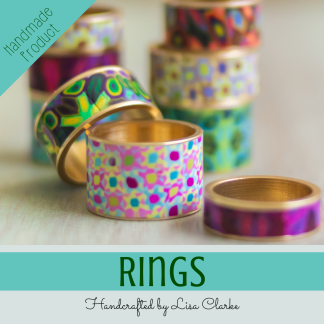
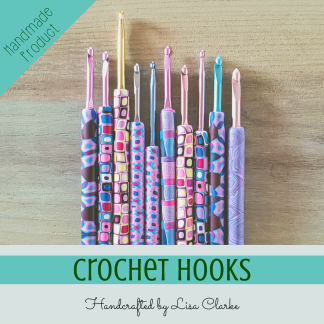
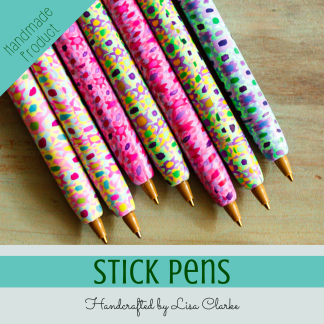
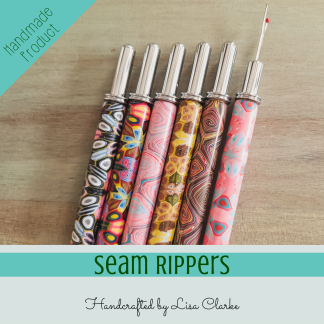

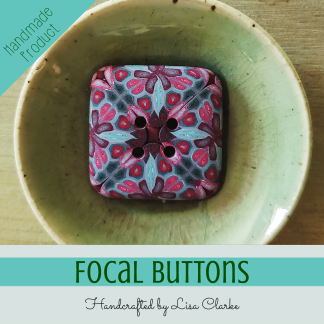
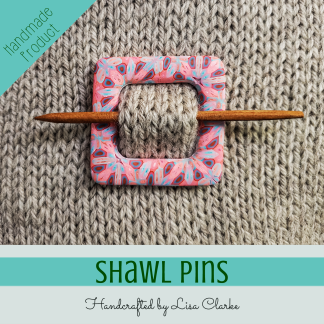












[…] decide what packages of clay we need to get us started. I do all of my caning in Sculpey III (read this, if you’d like to know why) so when I refer to clay colors, it will be Sculpey […]
Thank you for your comment on my blog about why Sculpey III makes me so mad.
This is a great post Lisa, and now I get why you are working with Sculpey III. Maybe I won’t throw out the Sculpey III I still have… I just won’t make anything structural with it or give it to my kids.
You bring up a great point about Premo and Fimo canes firming up over time. This happened to me in an extreme way once when I wrapped my canes in a plastic wrap that contained plasticizers. It sucked all the plasticizer out of the clay with in a few days and they got hard as a rock.
I pulled some of them ‘out of the abyss’ by wrapping the canes in a layer of Fimo Mix Quick, with the theory that the plasticizers would soak back into the clay. It worked great… Just had to trim off the Mix Quick around the cane a week or so later!
See what Cindy Lietz has been blogging about: Soften Polymer Clay with Fimo Quick Mix
Thanks for that info. I just have one question now. How do you not sand off any of the design when you use a thin layer of cane? Or does your layer of Kato liquid give it the finish you need without all that sanding?
I appreciate you sharing this with me because I love the colors of Sculpey III.
I don’t sand. I do as much as I can to minimize the need for sanding before I bake, and I like the finish of the Kato liquid enough just to leave it natural.
I do admit, though, that the finish really can’t compare to a sanded and buffed one. They are a bit different. To me, though, the extra labor required to sand every button isn’t worth it. It would require me to price them too high to sell.
Hope this helps!
Thank you for this article. I am a Sculpey junkie too! And it aggravates me no end when other clayers look down their nose at pieces made with Sulpey III. I have been using it for quite some time now (since about 1995 or so) when I first started with polymer clays. No other clay offers the(non changing when baked)colors that Sculpey does, or the ease of workability. Not to mention the price and availability. Although I am a bit disappointed with the colors they have discontinued recently. I am still addicted to this wonderful brand. Oh, and before you ask? Yes I did try several other clays, even cernit. And did not get the satisfaction with the clay or the results that I get with Sculpey. But thank you for the tip about the liquid Kato. I will try that. I mostly make beads with my clay and I have never had an issue with strength. But I am always looking for a nice finish to use on them. Sincerely, Jamie.
Very interesting report. I never had any problem with my old premo canes and some are more than 6 yrs old.Lucky I guess. Will give a try to the sculpey lll. Some of their colours are so yummy.
[…] helped me name these color schemes. Some resemble the old (old, OLD) color schemes I had back in my Sculpey days, so I just used those names, but the rest needed some […]
[…] know how I feel about Sculpey, so I hate to admit this, but they were awful. I mashed up nearly everything I made from them. […]
[…] a more professional grade clay. I was still a Sculpey III girl when I made the old ones. I used Premo as a core, but the veneer was Sculpey. If you don’t […]